Intel’s Push to Enthusiasts: Soldered CPUs and 6.9 GHz Overclocks
by Ian Cutress on October 11, 2018 1:45 PM EST- Posted in
- CPUs
- Intel
- Overclocking
- LN2
- Core 9th Gen
- Z390
- Liquid Nitrogen
- Core i9-9900K
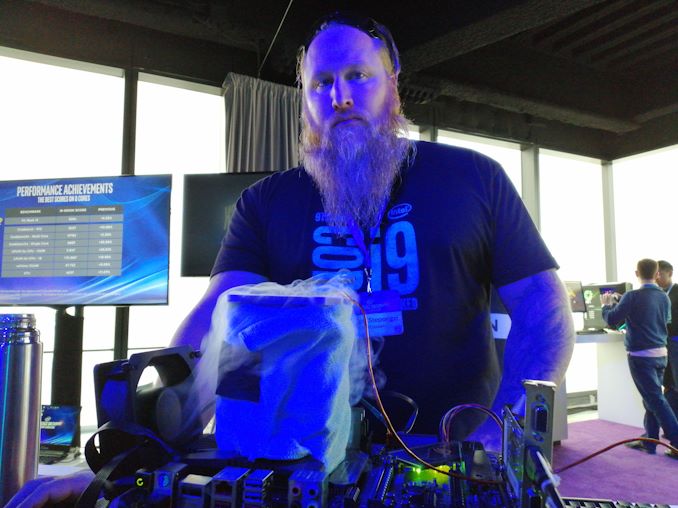
One of the prominent parts of Intel’s announcement this week for the new 9th Generation core processors was that both the overclockable consumer processors and the new high-end desktop processors all feature a soldered thermal interface material (STIM) between the silicon die and the heatspreader. This is a vast improvement over the previous thermal interface material due to the solder's superior ability to conduct thermal energy away from the silicon die. As part of the announcement, Intel also engaged in some extreme overclocking at its launch event using Liquid Nitrogen as an effective coolant, and some overclocking world champions.
Choosing A Thermal Interface Material (TIM)
With the desktop processors we use today, they are built from a silicon die (the smart bit), a package substrate (the green bit), a heatspreader (the silver bit), and a material that helps transfer heat from the silicon die to the heatspreader. The quality of the binding between the silicon die and the heatspreader using this thermal interface material is a key component in the processors ability to remove the heat generated from using it.
Traditionally there are two different types of thermal material: a heat conductive paste, or a bonded metal. Both have positives and negatives.
The heat conductive paste is a universal tool – it can be applied to practically any manufactured processor, and is able to deal with a wide range of changing conditions. Because metals expand under temperature, when a processor is used and gets hot, it expands – so does the heatspreader. The paste can easily deal with this. This allows paste-based processors to live longer and in more environments. Using a bonded metal typically reduces the level of thermal cycling possible, as the metal also expands and contracts in a non-fluid way. This might mean the processors has a rated lifespan of several years, rather than a dozen years. However, the bonded metal solution performs a lot, lot better – metal conducts heat better than the silicon-based pastes – but it is slightly more expensive (a dollar or two per unit, at most, when the materials and manufacturing are taken into account).
| Thermal Interface | |||||||
| Intel | |||||||
| Intel | Celeron | Pentium | Core i3 | Core i5 | Core i7 Core i9 |
HEDT | |
| Sandy Bridge | LGA1155 | Paste | Paste | Paste | Bonded | Bonded | Bonded |
| Ivy Bridge | LGA1155 | Paste | Paste | Paste | Paste | Paste | Bonded |
| Haswell / DK | LGA1150 | Paste | Paste | Paste | Paste | Paste | Bonded |
| Broadwell | LGA1150 | Paste | Paste | Paste | Paste | Paste | Bonded |
| Skylake | LGA1151 | Paste | Paste | Paste | Paste | Paste | Paste |
| Kaby Lake | LGA1151 | Paste | Paste | Paste | Paste | Paste | - |
| Coffee Lake | 1151 v2 | Paste | Paste | Paste | Paste | Paste | - |
| CFL-R | 1151 v2 | ? | ? | ? | K = Bonded | - | |
| AMD | |||||||
| Zambezi | AM3+ | Bonded | Carrizo | AM4 | Bonded | ||
| Vishera | AM3+ | Bonded | Bristol R | AM4 | Bonded | ||
| Llano | FM1 | Paste | Summit R | AM4 | Bonded | ||
| Trinity | FM2 | Paste | Raven R | AM4 | Paste | ||
| Richland | FM2 | Paste | Pinnacle | AM4 | Bonded | ||
| Kaveri | FM2+ | Paste / Bonded* | TR | TR4 | Bonded | ||
| Carrizo | FM2+ | Paste | TR2 | TR4 | Bonded | ||
| Kabini | AM1 | Paste | |||||
| *Some Kaveri Refresh were bonded | |||||||
In our Ryzen APU delidding article, we went through the process of removing the heatspreader and conductive paste from a popular low cost product, and we showed that replacing that paste with a bonded liquid metal improved temperatures, overclocking, and performance in mid-range overclocks. If any company wants to make enthusiasts happy, using a bonded metal is the way to go.
Intel on Enthusiasts
For several years, Intel has always stated that they are there for enthusiasts. In the distant past, as the table above shows, Intel provided processors with a soldered bonded metal interface and was happy to do so. In recent times however, the whole product line was pushed into the heat conductive paste for a number of reasons.

Slide for Intel's 4th Gen, which used paste
As Intel was continually saying that they still cared about enthusiasts, a number of users were concerned that Intel was getting itself confused. Some believed that Intel had ‘enthusiasts’ and ‘overclockers’ in two distinct non-overlapping categories. It is what it is, but now Intel has returned to using applying STIM and wants to court overclockers again.
Pushing Frequencies with Liquid Nitrogen
I should be safe in saying that most AnandTech readers understand that in order to push an overclock, bigger and better cooling is required. This might mean a good air cooler, water cooling, or if you want an exotic daily system, chilled water. The idea here is that as the voltage and frequency is raised, more exotic cooling is required to keep the system from overheating. Beyond chilled water, there are a bunch of enthusiasts that use sub-zero coolants.
Competitive overclocking is an industry to which I am relatively intimate: I have at some point in my existence hit #2 in the world rankings, albeit briefly. The nature of the extreme overclocking scene has changed from very motivated enthusiasts and engineers to vendor backed individuals with thousands of dollars in hardware trying to get the very highest frequency, or break particular benchmark world records. It comes down to experience, preparation, and a good amount of luck to get the best hardware and the best results in the world.
For example, the high-frequency world record on an AMD processor is 8794.33 MHz, using a FX-8350 under liquid nitrogen, whereas the Intel record is 8532.17 MHz on a Celeron 352. Each processor runs differently when you get down to -196C, and some of the older processors were better at pushing the envelope. But while newer processors might not clock as high, the additional cores and raw per-MHz performance help push the benchmarking part of the world records higher.
So while a good air overclock on a high-end gaming processor like the Core i7-8086K is around 5.4 GHz, under liquid nitrogen Intel’s hired guns on the day were pushing 6.9 GHz with the latest 9th generation Core i9-9900K on all cores, and reaching 7.1 GHz internally, with up to 7.4 GHz on a single core. Given that the chip is new, there are usually a good couple of months of learning a new platform and chip binning to push it as high as the previous generation, so we’re likely to see higher over the coming months.
The two overclockers hired by Intel, known in the community as Splave and Steponz, were happily breaking records for 8-core processors left right and center for various CPU focused tests. They also achieved at least one ‘global’ world record, beating every other processor that has ever existed, in PCMark 10.
For a few other tests, Intel achieved some best ever 8-core results.
What’s the point?
Not everyone is going to run liquid nitrogen on their system. Not only is the cooling setup a disaster to maintain 24/7, as well as expensive, the inherent instability in the system at this frequency and the tuning required isn’t practical as it requires constant tweaking. Extreme overclocking is often compared to drag racing – to see who can go the quickest quarter mile. There are several parallels – going for the highest frequency might be just a peak speed contest, while running a complex benchmark is more akin to Formula 1. There are users that have been competitive overclocking for decades, and for a select few, it has become a career that has ended up with motherboards that offer new features that everyone who wants to can use. Sure, it isn’t as useful as taking a family saloon to the shops, but it is fun to watch them go.
Related Reading
- Overclocking The AMD Ryzen APUs: Guide and Results
- The Intel Skylake i7-6700K Overclocking Performance Mini-Test to 4.8 GHz
- AMD Ryzen 5 2400G and Ryzen 3 2200G Integrated Graphics Frequency Scaling
- Delidding The AMD Ryzen 5 2400G APU: How To Guide and Results
- EVGA Roboclocker: A Water Cooling Loop for LIQUID NITROGEN
- GIGABYTE’s Liquid Nitrogen Memory Overclocking Motherboard, Z97X-SOC Force LN2
- Thermal Interface and Extreme Overclocking on the Core i7-8086K (with Alva Jonathan)



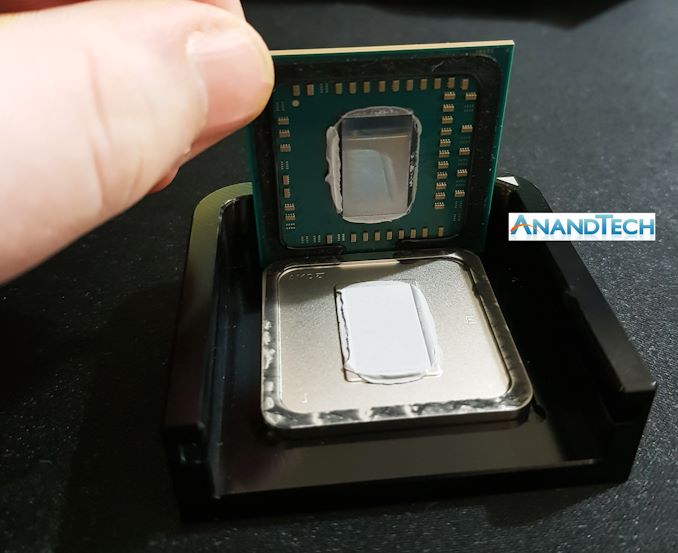
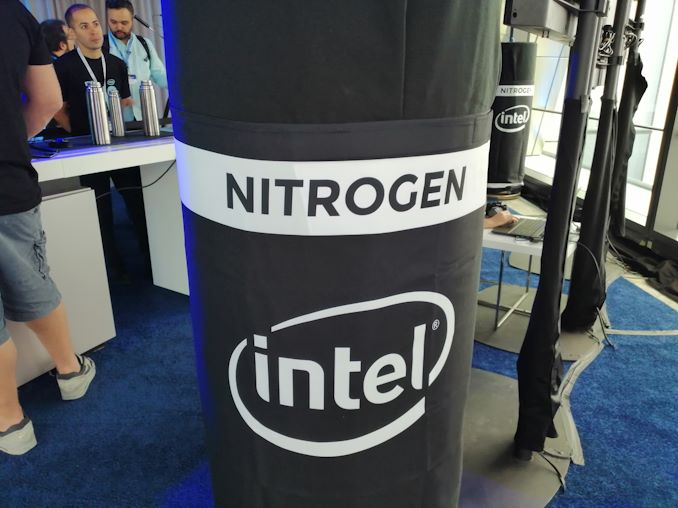
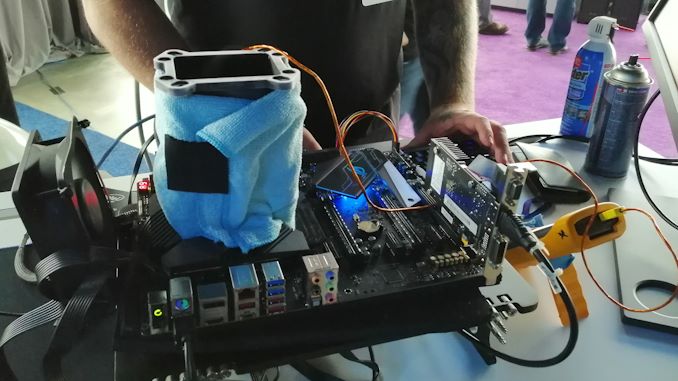
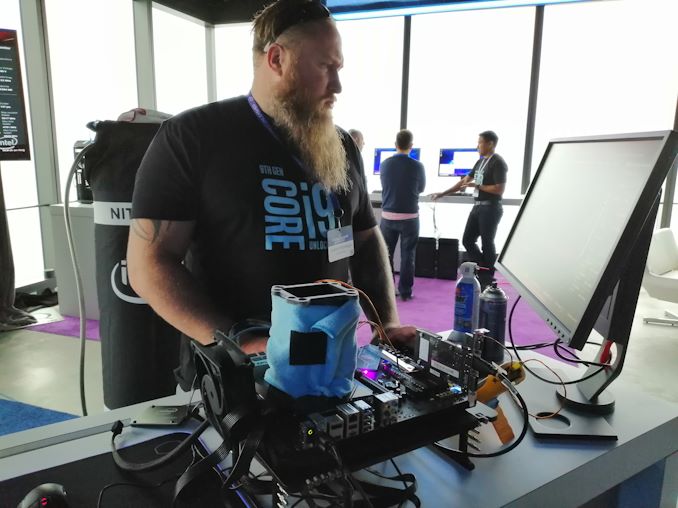









54 Comments
View All Comments
rocky12345 - Thursday, October 11, 2018 - link
For those tests posted such as PCMARK 10 and others was this overclocked on LN2 to get those scores?Ian Cutress - Thursday, October 11, 2018 - link
Yes.Zingam - Friday, October 12, 2018 - link
I don't get it why so much emphasis is put on overclocking reviews when only 0.00000001% of the users do overclock their stuff. It is nothing but a semi-useless marketing bullshit.What I care is what I believe those other 99.0000009% of the users care price, stability, longevity, normal performance, power usage/battery life, heat and noise. Did I mention stability and security?
Death666Angel - Friday, October 12, 2018 - link
First of all, I would dispute your claim that a negligible amount of people OC their stuff. Yes, it isn't half or even 10%. But it's more than 10^-8%. Also, your numbers don't add up to anything meaningful (99.00000091%).Zingam - Saturday, October 13, 2018 - link
Are some kind of a Number-Nazi counting the zeros? :)))just4U - Monday, October 15, 2018 - link
I'd think there are many reasons for it.. One being it can be a indicator of the potential of future mainstream products.Achaios - Friday, October 12, 2018 - link
I run my CPU 90% of the time with even the Turbo disabled (through Real Temp 3.70), however the rest 10% of the time my 4770K runs at 4.6 GHz while gaming.As a veteran WoW gamer, ppl (when I say "ppl" I mean everyone and their little brother/sister) I know have been overclocking their chips to extreme levels at least since 2004, b/c not overclocking your CPU back then meant that you simply COULD NOT play the game. It wasn't funny or easy trying to raid in the World of Wacraft and run Teamspeak on a Pentium 4 mono-core 3.06 GHz with HT.
World of Wacraft alone has had over 50,000,000 players in its lifespan. Even Anand himself used to play WoW Vanilla on a Pentium 4. This shows how much BS your post contains. If ANANDTECH had a neon sign installed of a man shoveling up BS on his cart to denote unbelievabe BS, it would have gone off now. 'Nuff said.
PeachNCream - Friday, October 12, 2018 - link
That's odd. WoW ran fine for me on a Northwood 2.4GHz P4 with no overclocking. It was a little bit slow in crowded areas like around Stormwind's bank during the after school rush, but was relatively smooth in raids. I never felt the need to overclock it.Achaios - Saturday, October 13, 2018 - link
Ah no it wasn't. See, I still have my original 2005 laptop and I tested it on a private Vanilla server. While you can limp along while questing at 30 FPS, any group content is impossible with a 3.06 GHz Pentium 4. Raids are absolutely impossible. You are just full of it. Case in point: https://imgur.com/Y9oQ6xWdesolation0 - Saturday, October 13, 2018 - link
I'm not sure what kind of graphics solution or the heat situation you had in your laptop. On desktop the 2004 era Prescott Pentium 4 3.2 GHZ ended up pulling okay numbers into the start of Wrath of the Lich King when upgraded with a newer graphics card that was still compatible with an AGP graphics slot, eventually the Radeon HD 4650. Obviously this was with quite lower graphics settings.